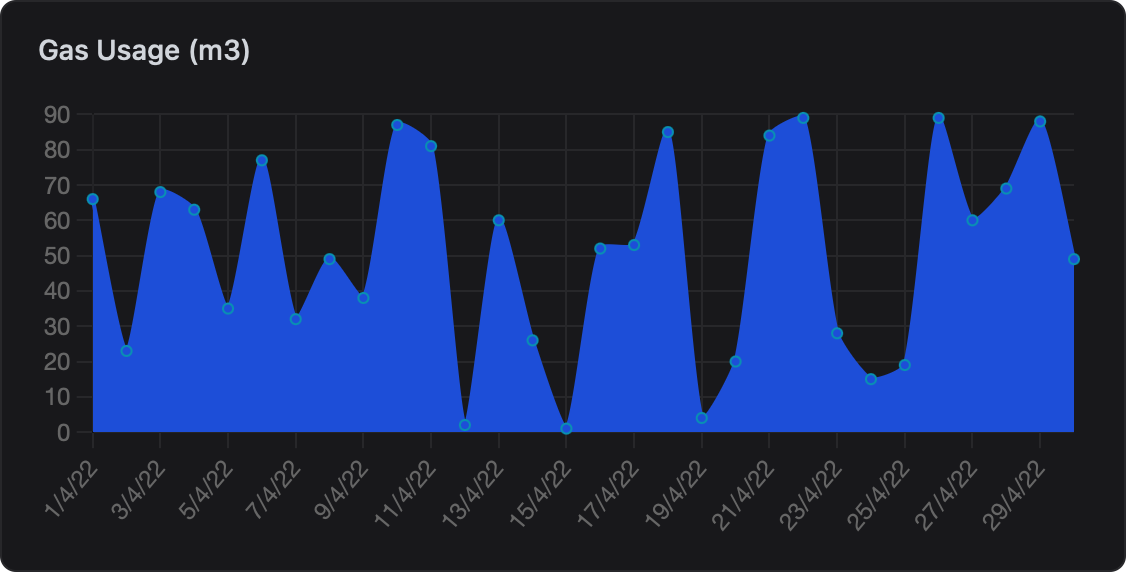Area Chart

Area charts are useful for visualizing cumulative totals over time or categories. In ESP-DASH v5, the dash::AreaChart<X, Y> class provides a flexible, type-safe way to create and update area charts with a variety of data types.
Initializer
To create an area chart, instantiate dash::AreaChart<X, Y> with your dashboard instance and a descriptive title. The template parameters X and Y define the types for the X and Y axes, respectively. Choose types that match your data:
Example 1: String labels (months), integer values
// X-axis: months (labels), Y-axis: rainfall (int)
dash::AreaChart<const char*, int> area(dashboard, "Cumulative Rainfall");Example 2: Integer X, float Y
// X-axis: time (days), Y-axis: growth (float)
dash::AreaChart<int, float> area2(dashboard, "Growth");Example 3: Float X and Y
// X-axis: float (e.g., time), Y-axis: float (e.g., value)
dash::AreaChart<float, float> area3(dashboard, "Value");Just make sure the arrays you pass to setX and setY match the types you specify in the template.
Callback
Area charts are for data visualization and do not require a callback for user interaction.
Methods
setX(X arr_x[], size_t x_size)
Sets the values for the X-axis. The type of arr_x must match the template type you chose for X.
// If X is const char* (labels):
area.setX(XAxis, 4); // XAxis is const char*[]
// If X is int:
area2.setX(timeArray, 10); // timeArray is int[]- Signature:
void setX(X arr_x[], size_t x_size) - Parameters:
X arr_x[]— Array of X-axis values.size_t x_size— Number of elements in the array.
- Returns:
void
setY(Y arr_y[], size_t y_size)
Sets the values for the Y-axis. The type of arr_y must match the template type you chose for Y.
// If Y is int:
area.setY(YAxis, 4); // YAxis is int[]
// If Y is float:
area2.setY(growthArray, 10); // growthArray is float[]- Signature:
void setY(Y arr_y[], size_t y_size) - Parameters:
Y arr_y[]— Array of Y-axis values.size_t y_size— Number of elements in the array.
- Returns:
void
x()
Returns a pointer to the current X-axis data array. The return type matches your template type for X.
// If X is const char*:
const char** labels = area.x();
// If X is int:
int* times = area2.x();- Signature:
X* x() - Parameters: None
- Returns:
X*— Pointer to the current X-axis data array.
y()
Returns a pointer to the current Y-axis data array. The return type matches your template type for Y.
// If Y is int:
int* values = area.y();
// If Y is float:
float* growths = area2.y();- Signature:
Y* y() - Parameters: None
- Returns:
Y*— Pointer to the current Y-axis data array.
Reference
Below is a complete example showing how to initialize and update an area chart. Comments explain each step for clarity.
// Create an area chart for cumulative rainfall
// X-axis: months (labels)
// Y-axis: rainfall values
dash::AreaChart<const char*, int> area(dashboard, "Cumulative Rainfall");
// Data arrays must be global so the chart can access them at any time
const char* XAxis[] = {"Jan", "Feb", "Mar", "Apr"};
int YAxis[] = {10, 25, 40, 60};
void setup() {
// Set X and Y axis data for the chart
area.setX(XAxis, 4);
area.setY(YAxis, 4);
}
// Later in your code, you can update YAxis[] values directly to update the chart in real time